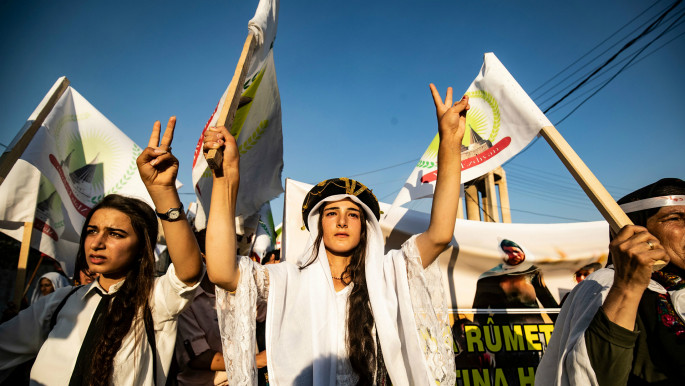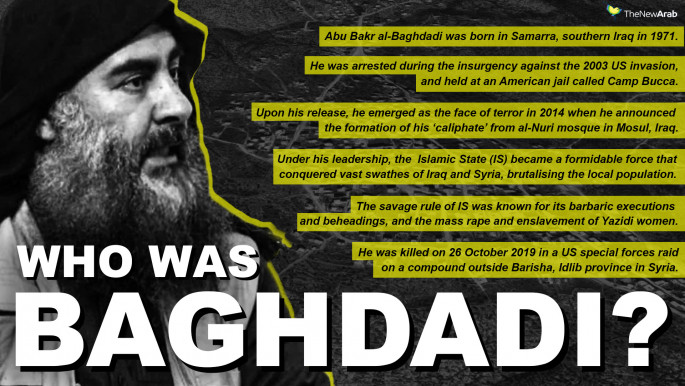Syria Weekly: IS poses new threat after Baghdadi death
Although Baghdadi’s killing undoubtedly marks a blow for IS, which lost the last of its territories in Syria last March, the event is not being viewed as a potential death knell for the group.
IS was already on its way to reposition itself as an insurgency-cum-underground terror organisation when Baghdadi was killed, and his death will likely inspire revenge attacks, western security experts have warned.
 |
|
| [Also read: 'Now we await our fate': Displaced Yazidis fear loss of land in Syria] |
“When bin Laden was killed, al-Baghdadi unleashed violent retaliation. Security services will now be braced for attempts to avenge his death,” said Richard Kemp, former head of international intelligence at the UK Cabinet Office this week.
Baghdadi death
The concept and legacy of the group’s brief “caliphate” will likely endure after Baghdadi’s death and inspire a new generation of jihadi sympathisers with IS already naming a new “caliph” to guide the followers in what could be a new phase for the organisation.
US President Donald Trump from struck a triumphant tone on Sunday when he announced the death of Baghdadi, following repeated claims that Washington had “defeated” IS.
Trump come under intense criticism over the past three weeks for withdrawing American troops from northern Syria, a decision that appeared to greenlight a Turkish offensive against Kurdish forces in the area.
Details of Baghdadi’s death have not yet been verified but what is clear is that a surprise raid by US Delta Forces in northern Idlib led to a battle with guards, allowing Baghdadi to escape through a tunnel with no exit. Pursued by a US army dog, Baghdadi detonated a bomb belt killing himself and three children, according to The New York Times.
The death of America’s enemy number one has undoubtedly been a PR success for Trump, but security analysts have noted that other jihadi leaders have come and gone, including the founder of Al-Qaeda in Iraq Abu Musab Al-Zarqawi, whose insurgency group eventually morphed into what we know today as IS.
Baghdadi also lacked the charisma of former Al-Qaeda leader Osama bin Laden, whose death sparked a downturn in fortunes for the group with IS becoming the most attractive group for jihadi sympathisers across the world.
Dareen Khalifa, senior Syria analyst at the International Crisis Group, told The New Arab that it is clear Baghdadi acted more of a figurehead for the group than commander, whose territorial ambitions ended in March with the fall of Baghouz.
“Baghdadi and the ISIS leadership were providing broad, strategic guidance to the organisation globally, but not day-to-day, command-and-control, and the group can likely continue with their existing marching orders [while their] institutionalised knowledge might very well live on,” Khalifa said.
“The organisation’s appeal does not seem to be personalistic. Baghdadi has made only two appearances on video, in addition to his various audio recordings. Those around him are kept deliberately anonymous.”
Along with Baghdadi, IS spokesperson Abu Hassan Al-Muhajir was killed in a separate raid in northern Syria this week. All other major figureheads within the group are long dead, including Chechan commander Abu Omar Al-Shishani and IS deputy Mohammed Al-Adnani.
 |
|
| [click to enlarge] |
New threat
IS are also no longer able to launch huge conventional assaults against their foes, as they did in 2014 and 2015. Instead they have started something of an insurgency in eastern Syria, with hit-and-run attacks on security forces and murdering locals who have worked with Syrian Democratic Forces authorities.
In central Syria, militants also operate from a series of mountainous hideouts that regime forces have not yet managed to capture, launching frequent raids on checkpoints and civilian targets, which has contributed to preventing locals from returning to their homes.
The attacks might be limited in nature but they serve as a vital propaganda tool in keeping the myth of IS and its “caliphate” alive, while the turmoil from the Turkish offensive in northern Syria has also impacted on the abilities of the SDF to continue their efforts to flush out the last remnants of the group.
 |
Now, all the important leaders are unknown, maybe they live among us |  |
“The YPG’s proactive anti-ISIS operations have continued despite the Turkish incursion, but at a much lower rate [and] overall there has not been a major breakdown in IS-related security… in Deir az-Zour there has been only one major attack claimed by IS this month,” Khalifa added.
Tim Ramadan, an alias for a Raqqa-based journalist and the founder of the Sound and Picture monitoring group, said that despite the conventional defeat of IS, the group is still feared in northern Syria.
“Now, all the important leaders are unknown, maybe they live among us,” he told The New Arab. “I think their numbers are increasing, not decreasing. Now there are many dormant cells, they are in the desert but also among us,” he added.
Read more: Pentagon releases first video, photos of raid that killed IS leader Baghdadi
Ramadan estimates that the group has 10,000 members in Syria and being forced underground, the group poses a new threat for civilians with sympathisers spread across the country, unknown and unmonitored.
“Who would have thought that Baghdadi would be hiding in Idlib? This shows that IS are everywhere, they no longer control the cities but they are now growing among the people,” Ramadan said.
Hurras Al-Din, a Idlib-based jihadi group, have been accused of providing cover for Baghdadi in Idlib and acting as an undercover affiliate for IS.
Although there are other questions over the relationship between the Al-Qaeda affiliate and IS, it is likely that more militants could have found their way into Idlib province over the past year.
“Idlib is surrounded by regime forces and the SDF militias, Baghdadi certainly had to cross through SDF or regime areas to reach Idlib. Thus there is another party other than Hurras Al-Din that helped Baghdadi to reach Idlib,” he said.
IS named its new “caliph” as Abu Ibrahim Al-Hashemi Al-Quraishi on Thursday, the name “Quraishi” likely referring to his alleged lineage to the Prophet Muhammed’s tribe.
Despite Trump saying on Friday “we know exactly who he is”, almost nothing is known about the Baghdadi’s replacement by the general public, although some believe Al-Quraishi could be an adopted name for a current IS commander.
“If he is the same person who we think he is, then the days will be very difficult,” Ramadan added. “He is more criminal than Baghdadi in many [ways].”
“Baghdadi died, but IS has not. Those who supported Baghdadi will also support the new Khalifa.”
Leaders such as Baghdadi and Zarqawi have acted as important figureheads for IS and Al-Qaeda in Iraq but the loose structure of IS has ensured that the organisation could survive and function under a new leadership, said Sam Hamad, a Scottish-Egyptian activist and writer, who has researched the group over the years.
 |
The bloody fall of IS will also play on the conscious of sympathisers and help romanticise the brief period of IS’ “caliphate”. |  |
“IS are proven survivors and the figureheads, whether it was the progenitor of the group, Musab Al-Zarqawi, or Abu Bakr Al-Baghdadi, they usually have superficial roles,” Hamad told The New Arab.
“Even Zarqawi despite his huge influence within the group was replaceable. This will be even more the case with Baghdadi, who despite giving himself the lofty title of ‘Khalifa’ wasn’t in any way essential to the day-to-day operation of IS. If you take out the wider factors, the people you would want to target to really hit the organisation are the middle men - the people who do the fundraising, the propaganda, the tactics and strategies.”
The ability of IS, at its peak, to control 110,000 square kilometres of territory and rule over almost 8 million people will likely provide jihadi propaganists with a catalogue of mythicised yarns to spin for years to come.
The bloody fall of IS will also play on the conscious of sympathisers and help romanticise the brief period of IS’ “caliphate”. The conditions for the group’s emergence in Iraq and Syria still remain in place and will continue to feed into a sense of injustice among some, Hamad believes.
“Iraq [remains] with a corrupt, sectarian government hellbent on denying Sunnis autonomy or simply fair treatment in the north which is the perfect breeding ground for IS… in Syria, there’s no doubt that as long as Bashar Al-Assad stays in power, and as long as the dynamics of the war remain in place, it will also be a breeding ground for IS in different forces. Nothing has changed,” Hamad said.
Paul McLoughlin is a news editor at The New Arab.
Follow him on Twitter: @PaullMcLoughlin





 Follow the Middle East's top stories in English at The New Arab on Google News
Follow the Middle East's top stories in English at The New Arab on Google News


